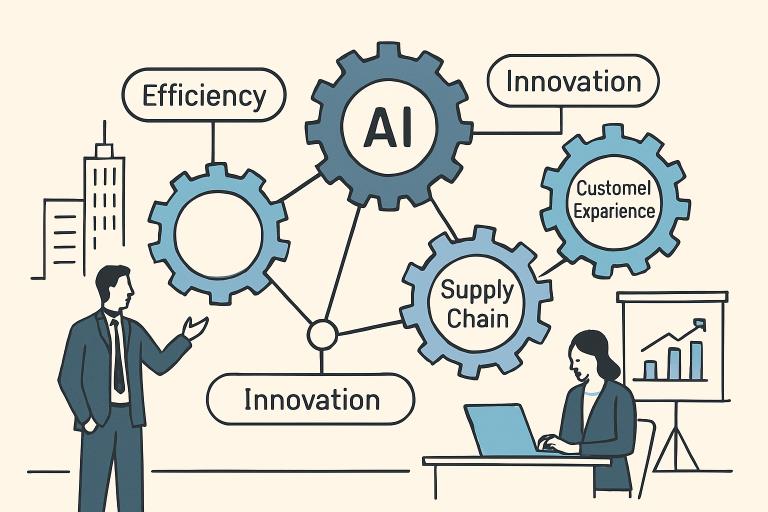Now Reading: How Digital Transformation Shapes Data Privacy and Information Security
-
01
How Digital Transformation Shapes Data Privacy and Information Security
How Digital Transformation Shapes Data Privacy and Information Security

As organizations adopt new technologies to stay competitive, digital transformation shifts data privacy training and security boundaries. Modernizing operations, boosting productivity, and meeting customer expectations bring new opportunities and risks in data collection, storage, and protection. The growth of personalized data makes information security a strategic priority, extending responsibilities beyond IT to compliance, HR, employees, and customers, requiring ongoing privacy assessments.
From cloud computing to AI and IoT, digital advances boost efficiency but pose privacy and security challenges. Cloud platforms speed up development and collaboration but also increase risks of data loss and cyberattacks. Navigating these requires understanding threats, strong data management, and privacy tech—key for adapting. Success depends on planning security early, not later. Businesses must invest in privacy to retain trust and comply with regulations. Data breaches harm reputation and incur penalties. Building a security-first culture is crucial in today’s digital shift. Industry leaders emphasize that privacy must be a continual focus—a journey, not a destination—requiring adaptability to new regulations, threats, and technologies as they emerge. Implementing regular data privacy training for employees is a key step in ensuring everyone understands their role in safeguarding sensitive information and maintaining organizational trust.
For a more comprehensive perspective on why prioritizing privacy is essential at every stage of digital innovation, consult this resource, which provides expert security guidance for organizations of all sizes. These resources feature case studies, best practices, and regulatory updates to help companies navigate an ever-changing risk environment with clarity and confidence.
The Rise of Digital Transformation
Digital transformation signifies the integration of digital tools and processes across every facet of business operations. By leveraging cloud architecture, big data analytics, and interconnected devices, companies unlock opportunities for cost savings, scalability, and faster innovation. Firms can transform how they interact with customers, uncover operational inefficiencies, and quickly adapt to changing market conditions. However, as digital systems deepen their reach, traditional security perimeters fade, ushering in new vulnerabilities and attack vectors. Thoughtful adoption of new technologies must be counterbalanced with robust security measures that evolve in tandem.
Data Privacy Challenges in the Digital Age
With the explosion of data-driven services, organizations confront enormous privacy complexities. The widespread deployment of IoT devices means data is collected almost everywhere, often passively and at a massive scale. Connected vehicles, smart buildings, wearable health trackers, and household appliances all amass user and behavioral information on a continuous basis. Unchecked, this can lead to unauthorized data harvesting, invasive surveillance, or exposure of personal information. Privacy incidents may spark regulatory investigations or consumer backlash, especially if individuals feel their data is used beyond intended or disclosed purposes. AI and advanced analytics further magnify risk, as sophisticated models may unintentionally reveal patterns tied to individuals unless robust anonymization steps are in place. Responsible stewardship now requires routine audits, impact assessments, and ongoing dialogue with stakeholders to build and maintain public trust.
Information Security Risks Amidst Digital Transformation
Expanding digital infrastructures broaden the threat landscape, exposing businesses to risks such as:
- Data Breaches:Gaps in digital defenses can lead to large-scale unauthorized access, with financial and reputational consequences. Cyberattackers continually refine their tactics to exploit misconfigured systems or unpatched vulnerabilities, often targeting sensitive customer, employee, or intellectual property data.
- Insider Threats:Employees and contractors, intentionally or otherwise, may access or mishandle confidential information. Social engineering, phishing, or simple negligence can open doors to bad actors or trigger accidental leaks. Strengthening internal controls is just as crucial as securing networks from the outside.
- Compliance Failures:The growing web of privacy regulations raises the stakes for missteps—potential penalties and lost customer confidence. Failing to keep pace with evolving legal requirements can stop digital initiatives in their tracks, undermining hard-won progress and trust.
Strategies for Enhancing Data Privacy and Security
Mitigating risks requires a proactive, structured approach. Effective strategies include:
- Granular Access Controls:Limit data access based strictly on roles and need-to-know principles to minimize risk exposure. Clear policies and automated enforcement tools can help ensure only appropriate individuals see sensitive information.
- End-to-End Encryption:Protect sensitive information during storage and transmission by adopting strong cryptographic protocols. Encryption not only safeguards data from unauthorized access but also demonstrates diligence to regulators and customers alike.
- Routine Security Audits:Regularly reviewing digital assets and security processes reveals weaknesses before adversaries can exploit them. Scheduled vulnerability scans, penetration testing, and red teaming exercises all contribute to a stronger, more resilient security posture.
- Comprehensive Employee Training:Ongoing education in best privacy and security practices prepares staff to recognize and avoid emerging threats. Simulated phishing tests, clear reporting channels, and up-to-date training platforms should be part of every organization’s digital defense plan.
The Role of Privacy-Enhancing Technologies
Privacy-enhancing technologies (PETs) allow for safe analysis and sharing of data while minimizing risk to individuals. Differential privacy algorithms add “noise” to datasets, protecting personal data during statistical analysis. Federated learning trains machine learning algorithms across decentralized data without data ever leaving its source, maintaining privacy. These approaches preserve analytical utility while making it difficult for attackers to reconstruct sensitive records. Modern anonymization techniques, including synthetic data and tokenization, empower organizations to derive business value without violating user confidentiality. For a deeper dive into current PET trends and use cases. Early adoption of PETs signals to customers and partners an organization’s ongoing commitment to privacy by design and helps build competitive differentiation in crowded markets.
Regulatory Landscape and Compliance
The regulatory environment is becoming ever more complex. Frameworks such as the EU’s General Data Protection Regulation (GDPR) and California’s Consumer Privacy Act (CCPA) establish tough new standards for data governance and transparency. Laws now require that organizations provide clear disclosures on how data is collected and used, while also implementing rigorous security controls. Compliance requires organizations to not only secure data but to empower users with rights over their information—including the ability to access, correct, restrict, and delete it. Noncompliance can result in substantial fines and remediation costs, making regulatory vigilance a continuous business requirement. Maintaining compliance also builds stakeholder confidence, positioning brands as responsible custodians of user data in an age of growing public awareness about digital privacy issues.
Case Studies of Successful Implementation
Examples abound of organizations overcoming digital transformation risks through coordinated security and privacy strategies. The National Health Service (NHS) in the United Kingdom, for instance, created a centralized Cyber Security Operations Centre to actively monitor digital threats, safeguarding key infrastructure and patient records against billions of malicious attacks. Their approach features advanced threat detection, swift incident response, and collaboration with government agencies—a model for other critical sectors. Similarly, global financial institutions are utilizing federated analytics to extract insight from sensitive financial data for fraud prevention—without exposing underlying customer information. By leveraging such innovations, these organizations demonstrate that privacy protection and data-driven transformation can go hand in hand.
Conclusion
Digital transformation is reshaping industries and redefining how data flows across the globe. The key to unlocking its benefits, while protecting individuals and organizations, lies in adopting a security-first mindset—built on strong privacy training, regulatory compliance, and cutting-edge technologies. In doing so, businesses not only reduce risk but foster lasting trust in a digital-first era. The balance between innovation and protection will ultimately determine the resilience and reputation of organizations as the digital landscape continues to evolve.




















